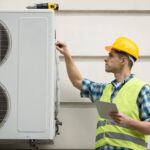As a new homeowner, ensuring your home has the right heating system is essential to maintaining comfort during colder months. Furnace installation is a significant investment; understanding the process can make all the difference. We will explore the steps involved in professional furnace installation, from selecting the right unit to the importance of professional services and the long-term maintenance required. Whether upgrading an old system or installing a furnace for the first time, we will provide the necessary insights to navigate the process effectively. To learn more about Kramer & Sons Plumbing Services, Inc services, please visit our website.
Understanding Your Home’s Heating Needs
Before diving into furnace installation, it is important to understand the specific heating needs of your home. Factors such as the size of your home, insulation, and climate conditions play a crucial role in determining the type of furnace you should install. For instance, larger homes or homes in colder climates typically require a more powerful furnace to maintain consistent heat. A professional will assess these factors to recommend the ideal furnace model that will efficiently meet your needs while keeping energy consumption in check. Additionally, the layout of your home, including the number of floors and rooms, will affect airflow and heat distribution, which is why a proper assessment is essential.
Furnace size is measured in BTUs (British Thermal Units), representing the amount of heat the furnace can generate per hour. Choosing a unit that is too large or too small for your home can lead to inefficiency, higher energy bills, and inconsistent heating. A professional installer will help you select a furnace with the appropriate capacity, ensuring comfort and energy efficiency. By understanding these basic principles, you can better prepare yourself for discussions with a professional and make a choice that suits your home’s needs.
Selecting the Right Furnace for Your Home
Once you clearly understand your home’s heating requirements, it is time to choose the right furnace. Different furnaces, including gas, electric, and oil, each offer advantages. Gas furnaces are generally the most popular choice due to their cost-effectiveness and ability to provide consistent heat. They are fueled by natural gas and are often more affordable than electric or oil furnaces. On the other hand, electric furnaces are more efficient in areas with limited access to natural gas, but they may have higher operating costs in the long run. Oil furnaces are typically used in areas where gas is not readily available but are becoming less common due to increasing fuel costs.
Energy efficiency is another key factor to consider when selecting a furnace. Modern furnaces have high-efficiency ratings, usually expressed as Annual Fuel Utilization Efficiency (AFUE) percentages. The higher the AFUE, the more efficient the furnace converts fuel into heat. This is an important consideration as it can affect your home’s heating costs over the years. While high-efficiency furnaces tend to have a higher upfront cost, they can save you money in the long run by reducing energy consumption. A professional will assist in evaluating your options and help you make an informed choice based on your budget and preferences.
The Furnace Installation Process
The installation process is complex and requires professional knowledge and skill. It typically begins with assessing your home to determine the best location for the furnace. The furnace should be installed where it can efficiently distribute heat throughout the house while maintaining proper ventilation. The installer will also ensure the unit is correctly sized to meet your home’s heating demands.
After determining the location, the installation team will connect the furnace to the necessary gas, electrical, or oil lines. This step involves careful attention to detail to ensure safety and compliance with local building codes. The venting system is then installed to ensure exhaust gases, such as carbon monoxide, are safely expelled from the home. The installation also includes connecting the furnace to the thermostat and calibrating the system to ensure it operates effectively. The final step is a thorough inspection to ensure everything functions properly before the system is turned on for the first time.
Working with a professional who follows safety protocols and adheres to local regulations during installation is important. An improperly installed furnace can pose serious safety risks, such as gas leaks or fire hazards. Professionals are trained to handle these tasks efficiently and safely, ensuring your home remains protected.
Importance of Professional Furnace Installation
While it may be tempting to try and install a furnace yourself to save money, hiring a professional is crucial for several reasons. First and foremost, professionals have the training and experience necessary to install furnaces correctly, ensuring that all components are in place and working as they should. They are familiar with local building codes and regulations, which means that the installation will meet all legal requirements and pass inspection.
Additionally, professional installers are equipped with the right tools and equipment to handle the installation process safely. Furnaces involve complex systems such as gas lines, electrical connections, and ventilation, which require careful handling to avoid dangerous situations.
Furnace installation is crucial for new homeowners who want to maintain comfort and warmth during the winter. Understanding your home’s heating needs, selecting the right furnace, and opting for professional installation can ensure a smooth and efficient process. The installation itself requires precision and safety, making professional assistance indispensable. Ongoing maintenance is just as important, as it ensures that your furnace continues to function efficiently and reliably. By investing in proper installation and regular upkeep, you can enjoy years of reliable, cost-effective heating for your home.







